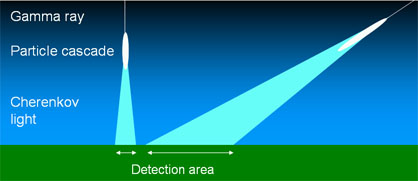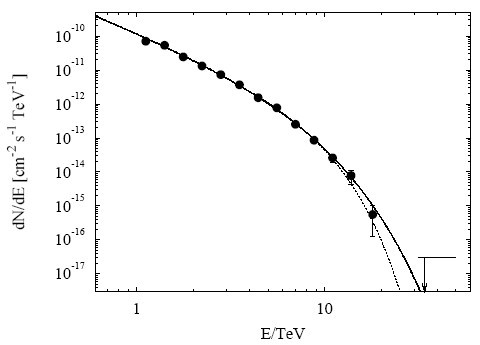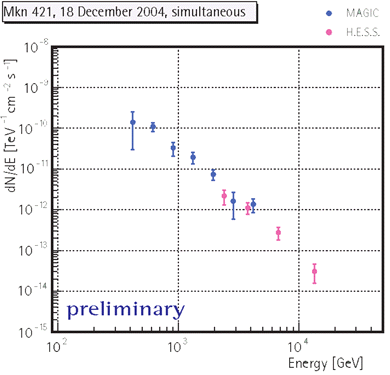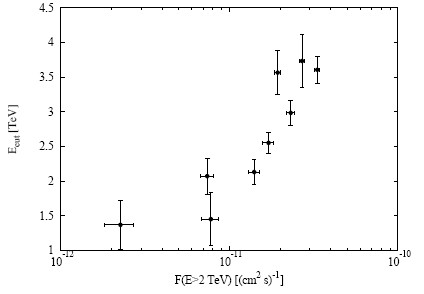Markarian 421 - a Fresh Look at a Familiar Source
October 2005

Markarian 421 was the first extragalactic source of very high energy gamma rays discovered (Punch et al. 1992). It is an active galaxy with a supermassive black hole at its core, emitting a jet of particles pointed towards us (see also PKS 2155-304). At a redshift of 0.03, it is relatively nearby. This source is known to exhibit flaring activity, where the emission increases by factors up to 100, with year-long quiescent periods in between. The time scale of the flares varies down to 15 min. and below (Gaidos et al. 1996), indicating that the emission region is of a similar scale as the solar system, and that the emission must be driven by processes occurring rather close the central engine of the active galaxy - the black hole. High-energy particles in the jet are believed to be responsible for the gamma-ray emission; since a correlation between the activity in very high energy gamma rays and in X-rays is observed (e.g. Blazejowksi et al. 2005), it is likely that the gamma rays originate from accelerated electrons, generating X-rays by synchrotron radiation and very high energy gamma-rays by upscattering of lower-energy photons, or of the synchrotron-radiation X-rays.
At a declination of 38 degr. N, the northern-hemisphere object Markarian 421 reaches only shallow elevation above ground when viewed from the Namibian H.E.S.S. site (at 23 degr. S); it culminates at an elevation around 30 degr. and has therefore to be observed through a large air mass. What at first sounds like a significant disadvantage has an interesting side effect (top illustration): since the particle cascade generating the Cherenkov light is much further from the telescopes than usual, the light spreads out and covers a much larger area on the ground. The resulting lower intensity of Cherenkov light implies that the energy threshold of the instrument is increased by a factor 10, from about 100 GeV for observations near zenith to about 1 TeV. However, since the Cherenkov light is so spread out, the area over which showers can be detected increases to two square kilometers, with a corresponding gain in detection rates. Observations at low elevations therefore allow one to measure the high-energy part of the spectrum with improved precision (see also Tanimori et al. 1994, Krennrich et al. 1999). The energy spectrum determined with H.E.S.S. (Fig. 1) extends from 1 TeV to well beyond 10 TeV. At the high-energy end, it shows deviations from the usual power-law spectra, indicating that the acceleration process "runs out of steam" or that particles there lose their energy faster - e.g. by synchrotron radiation - than the acceleration mechanism can supply. The energy of the spectral break varies with the gamma-ray flux (Fig. 2); an explanation is that the high-flux states are caused by fresh injection of high-energy particles which then lose their energy, resulting in a reduction of both the gamma-ray flux and the energy of the break. Similar variations were observed in earlier episodes (Krennrich et al. 2002, Aharonian et al. 2002)
Wide spectral coverage is important to understand and model the processes in the source. An interesting technique to combine results from different observatories was recently explored for the first time: the H.E.S.S. and MAGIC Cherenkov instruments observed Markarian 421 simultaneously, H.E.S.S. at low elevation, covering high energies, and the La Palma based MAGIC instrument at higher elevation, covering the low-energy part of the spectrum (Fig. 3). Such combined observations may ultimately allow to extend spectral coverage of short flares by about one order of magnitude and a joint MAGIC/H.E.S.S. working group has been set up coordinate observations.
In addition to the detection of the well-known object Markarian 421 and the AGN PKS 2155-304 covered earlier, H.E.S.S. has discovered a number of gamma-ray emitting active galaxies at larger distances, which will be featured in this series in the next months.
References:
Observations of Mkn 421 in 2004 with H.E.S.S. at large zenith angles, F. Aharonian et al., Astron. Astrophys. 437 (2005) 95-99 and Concept of a Global Network of Cherenkov Telescopes (GNCT) and first joint observations of H.E.S.S. and MAGIC, D. Mazin et al., 29th Int. Cosmic Ray Conf., Pune, 2005.


